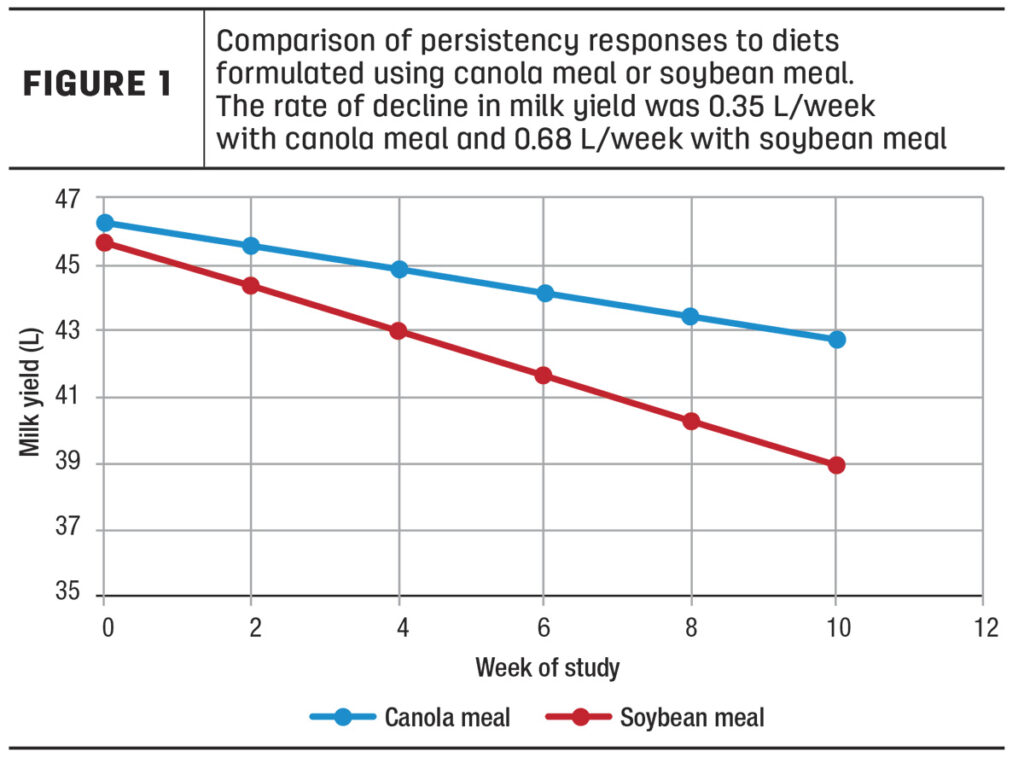

June 2023
Originally published in Progressive Dairy, written by: BRITTANY WOOD and ESSI EVANS
Over 40 scientifically referenced feeding trials evaluating the use of canola meal in lactating cow diets have been conducted since 2000. Most of the trials were two to four weeks long and evaluated cows after peak lactation. This is the easiest time in the lactation cycle to conduct trials because cows are declining in milk and are less likely to experience metabolic issues. The trial results consistently supported the use of canola meal in lactation diets, with an average increase of one litre of energy-corrected milk.
But a recent study showed we have more to learn – the study showed that feeding trials conducted over a two- to four-week period do not provide the full picture, and these findings may well change how future studies are conducted.
Graduate student Jordan Kuehnl and supervising professor Dr. Kenneth Kalscheur conducted a trial, comparing canola meal to soybean meal over a 10-week feeding period. An unexpected observation from the trial was a difference in persistency between the two sources of protein. Results are illustrated in Figure 1. The canola meal diet maintained milk production better than the soybean meal diet. At four weeks into the study, the difference in milk production between the two treatments was 1.3 litres per cow per day. This is similar to the average for many other feeding experiments. At 10 weeks, however, the differences in milk production between the two groups jumped to 3.3 litres per cow per day.

This showed that the canola meal diet supported greater production persistency. Usually, persistency is considered a genetic variable, but these results strongly suggest that nutrition plays a large role.
The original purpose of the study was to compare production responses of cows, grouped based on residual feed intake and given 16.5% crude protein diets (dry matter basis), where the supplemental protein was provided by either soybean meal or canola meal. Diet compositions are given in Table 1. Canola meal was substituted for soybean meal and soybean hulls in the control diet. The cows averaged 85 days in milk (past peak) when the trial started, and the trial ran for 10 weeks. Milk yield response to protein source was not different due to residual feed intake status of the cows. However, the researchers found that the rate of decline in milk production was lessened when cows received the canola meal diet.
| Ingredient, % of DM | Soybean meal | Canola meal |
| BMR corn silage | 45 | 45 |
| Alfalfa silage | 15 | 15 |
| HM corn | 19 | 19 |
| Soybean meal | 11.7 | 0 |
| Soybean hulls | 3.8 | 0 |
| Canola meal | 0 | 15.5 |
| Corn gluten meal | 2 | 2 |
| Fat | 1 | 1 |
| Minerals and vitamins | 2.5 | 2.5 |
The difference in yield for the entire trial was determined to be 2.7 litres per cow per day. However, had the experiment been terminated sooner, this value would have been less significant. This means that the value of different ingredients needs to be considered with respect to their effect on persistency.
The ability to maintain milk production past peak is an important economic parameter on the dairy. The cost required to feed and maintain the cow needs to be less than the revenue received from the milk she produces, so a slower rate of decline in milk yield after peak is ideal.
The length of the lactation cycle is not known until a cow is confirmed pregnant. Allowing the usual 60 days for the dry period, and a gestation period of 283 days, lactation should extend roughly 263 days beyond the date at which she was confirmed pregnant. Cows requiring a greater number of services per conception will experience a longer lactation. Milk production may not be profitable toward the end of the lactation cycle. This will depend on the cost of feed per cow per day and the value of energy-corrected milk:
Feed cost ($/cow/day) / milk price ($/L) = breakeven milk
For example, if feed cost per day is $11 and a litre of milk is valued at 80 cents, then cows producing 13.75 litres or less of milk are losing producers money.
When a cow is losing a producer money, the producer has three options: continue milking the cow at a loss, cull it or dry it off early. Milking at a loss may be necessary to meet quota. Culling pregnant cows can likewise be a financial burden and a drain on genetic progress. Drying cows early is a poor alternative as the cow may over-fatten, leading to calving difficulties and health issues in the subsequent lactation. The value of greater persistency increases with longer lactation periods.
If feeding variables can influence persistency, then there are opportunities to not only milk late breeders more profitably but to also extend calving intervals more profitably. To do so, more feeding trials need to include the determination of persistency along with treatment differences. While this may require longer feeding periods, the value of changes made to the diet can be evaluated more accurately than just comparing results from a relatively short feeding period.